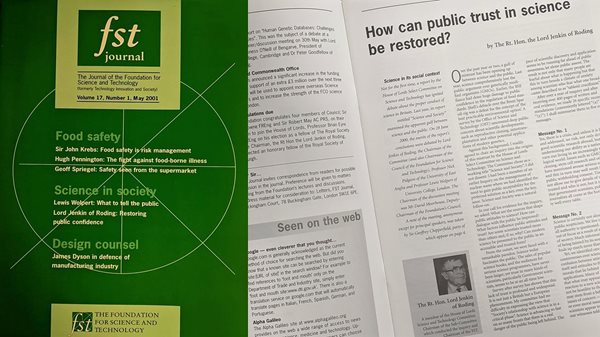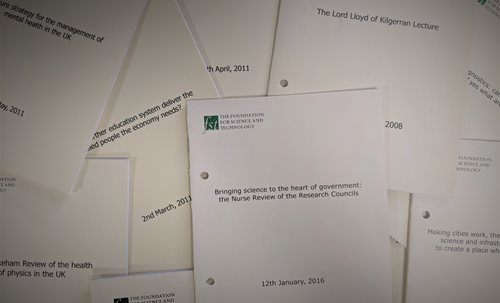HISTORY OF THE FOUNDATION
The Foundation's Early Years
1970s: A Foundation without a base
Discussions took place from the early 1970s to deliver the vision of a London Science Centre for learned and professional societies – a physical base to share accommodation and facilities all under one roof. However, this vision was challenged by lack of suitable properties with the required layouts for the foundation to fulfil its mission. The prospective property would ideally provide offices, meeting rooms, a library, car park, and most importantly, a refectory where people from different disciplines of the science and technology could meet informally and share ideas.
The Earl of Shannon was involved in many of these discussions, and when the Foundation was established, became its first Chair of Council.
Interestingly, the first prospective base for the London Science Centre could have been a convent, but the deal was stopped by the nuns. As claimed by The Earl of Shannon, he was “the only person ever to be gazumped by a Mother Superior.”

1977: The Foundation for Science and Technology is officially registered as charity
The Foundation was first registered as a company limited by guarantee, then as a charity. Simultaneously, the Foundation was given monetary support by established bodies, like the Royal Society, the British Academy, and the Commonwealth Foundation. With enough support, the London Science Centre, the Foundation’s working arm was established in an eleven roomed house, part of the Royal Society of Arts in Aldelphi.
Early 1980s: The London Science Centre is a bustling with activity
In late 1981, David Hall was appointed Director of the London Science Centre. Along with a staff of one plus a part timer, he set about filling the space out to meet part of the costs. Two of the largest rooms were given over to meetings for learned and professional societies; two small ones for the Centre’s offices; and the rest provided headquarter for small ‘not-for-profit’ societies. At the same time seminars and other events were organized for learned societies, which helped provide a much-needed injection of cash for the centre. However, cash flow forecasts indicated that for the Foundation to be sustained, every room of the centre had to be used to the maximum – days, evenings, and weekends. By 1982, the dwindling cash flow necessitated the Foundation to examine other options to be sustainable.
1982 onwards: revitalisation efforts underway
Following the realisation that innovative and alternative approaches were needed to keep the Foundation alive, several critical decisions were made. Firstly, the Foundation relocated from Adelphi to two rooms at the City University. This new accommodation offered advantages, such as meeting facilities for the seminars and workshops for learned societies, as well as lower rent. Consequently, the name “London Science Centre” was dropped to avoid public confusion between the names of the Foundation and its operational centre, and the name Foundation for Science and Technology was used exclusively from then on. Moreover, the Foundation realized that in order to be both sustainable and effective, it needed more than the learned society activities.
As a result, the Foundation decided to host a series of sponsored lecture and dinner discussions, named “Interdisciplinary Lectures”, and to establish a quarterly Journal. The Foundation also initiated the Register for Learned and Professional Societies which along with a monthly newsletter, attracted almost four hundred societies to register.
Lecture and dinner discussions: “Interdisciplinary Lectures”
In 1982, Sperry sponsored a lecture by Professor John Allen on “Offshore Artificial Islands” and a supper afterwards, and that was the first Lecture and Dinner Discussion held by the Foundation. These discussions helped the Foundation secure income out of the sponsorship contributions, to sit alongside learned society subscriptions, and other grants.
The Foundation has always taken pride in being independent of Government or any other institution, and this independence has been vital for maintaining the credibility of the lecture and dinner discussions, providing a neutral platform for expressing views. Over a relatively short period of time, these lectures and dinner discussions became the principal flagship activity of the Foundation, a combination of factors making them unique.
A standard format for these events emerged. Each discussion revolved around a timely relevant topic, with three or four speakers from different sectors presenting their viewpoints to the audience. This was followed by a break for networking and then dinner, with a second discussion period after dinner. This is still for format used by the Foundation today.
In 1983, the Foundation’s first Chair of Council stood down, and was replaced by Lord Lloyd of Kilgerran.
1988: The Foundation celebrates its tenth anniversary
On 13 April 1988, the Foundation celebrated its tenth anniversary with an event at the Royal Institution in the presence of HRH Prince Michael of Kent. Entitled “Man in Flight - Past, Present and Future”, this event comprised three speakers looking at aeronautics in different time periods. This was also the only time that a Foundation event has begun with two buglers in full livery delivering an opening fanfare.
Video recording of 10th Anniversary event
1992: The Lord Lloyd of Kilgerran Award
Lord Lloyd of Kilgerran passed away in 1991. At the time he was President of the Foundation, having recently passed over the Chairmanship to Lord Butterworth. In 1992, it was decided that an award in his name should be created “for the application of science and technology for the benefit of society, the award being made as near as possible to the time of benefit”. The broad criteria resulted in a varied list of recipients over several years, before the Award was phased out in the 2000s.
1993: The Foundation goes overseas
During the early 90s, and following a series of successful discussion dinners, the Foundation’s finances started growing, and Council decided that not only should there be events in the UK to give a better understanding of the workings of European partners through its events in London, but the Foundation should visit those countries and obtain that understanding first-hand.
The Foundation held its first event abroad in October 1993 jointly with the Frankfurt Chamber of Commerce and Industry, and the subject for the seminar and dinner discussion being “Innovation in the UK and Germany: Different Approaches to World Challenges”. This was followed in 1995 by a visit of 35 members to Paris for an evening seminar that was held jointly with the Paris Chamber of Commerce and Industry. Other visits abroad were to Berlin, Brussels, Geneva, Japan, and Dublin.
1997: Specialist support for Learned and Professional Societies
The Foundation was initially established to support the work of learned and professional societies. Although the Foundation was no longer providing accommodation for them in the London Science Centre, work to provide advice and guidance to them had continued in parallel with the expansion of other activities. In 1997, a specialist Learned and Professional Societies Officer with a legal background, Keith Lawrey, was appointed to lead on this work. The role consisted or organising seminars and events, organising surveys, providing advice on legal, governance and other matters, and producing the regular newsletter. Lawrey also produced and regularly updated “Notes for Guidance” on a range of governance issues.
Over the years, the support provided by the Foundation has changed. The initial demand for seminars fell away as others entered the marketplace and with more information available online. Similarly the annual survey of learned societies was phased out as it was less needed. On the other hand, the annual luncheon for Learned and Professiona Societies, offering networking opportunities and a talk on governance or operational issues, has been a key part of the annual programme, and has continued every year (except during the Covid period).
The most valuable - and sought-after - part of this work has been the 1:1 support that Lawrey has provided to learned and professional societies - on issues from Royal Charters to disciploinary issues, from changing governance documants to the protocol to be followed when a royal patron dies. This support remains a key function of the Foundation.
A new Chairman
Also in 1997, the third Chair of the Foundation’s Council, Lord Butterworth, stepped down, and was replaced by Lord Jenkin of Rodin.
2000: A new century, a new Chief Executive
At the turn of the Century, the Foundation was in a strong position, both reputationally – as an organisation which attracted top speakers and an active audience – and financially. After nearly 20 years at the helm, David Hall retired as Director and was replaced with Dr Dougal Goodman. Dr Goodman arrived with a career in the energy sector and public service – fifteen years at BP - and five years working for the British Antarctic Survey and six years at the Cavendish Laboratory in Cambridge. He had already built a wide network of contacts interested in policy choices and worked hard to expand this network.

His vision for the Foundation was to provide a neutral space for constructive debate on policy choices between parliamentarians, officials from Whitehall and the Devolved Administrations, industry, and senior managers from industry and the research community. Policy choices exist in a context drawing on science, engineering, technology and medical sciences. However, the target audience was as much the non-scientist as the scientist or engineer.
He was encouraged to participate in a variety of committees to make new contacts and raise awareness of the work of the Foundation. He chaired an initiative, 50 per cent funded by industry and 50 per cent funded by government with a total budget of £1 million - the Lighthill Risk Network - to facilitate the take up of research funded by government by the insurance market.
Governance and collaboration: The Trustee Board
From 1977 to 2016 the work of the Foundation was overseen by a Council of Directors and Trustees who were accountable for the spending of the funds raised by the charity and the work programme, but in 2016, the Governance structure was reviewed and a new structure adopted with a small Trustee Board.
The Chair of the board has traditionally been a member of the House of Lords. Lord Jenkin of Roding served as Chair until 2004, when he was replaced by the Earl of Selborne. John Selborne retired fro,m the role in 2018, and was succeeded by Lord Willetts. Council members have included: Presidents of the Royal Society, Royal Academy of Engineering, the British Academy, the Academy of Medical Sciences, the Engineering Council, the Science Council, the Royal Society of Edinburgh, the Learned Society of Wales and the Chairs of the Research Councils, Technology Strategy Board (renamed Innovate UK) and Higher Education Council for England (renamed Research England).
In 2018, the seven Research Councils were brought together as member organisations of a Non-Departmental Public Body - UK Research and Innovation. Whilst the Research Council Chair and Chief Executive were combined into one post - Executive Chair. Vice Presidents were appointed with no voting rights but were providers of sound advice. Other Council places were by invitation and included representatives of the research community, the justice system, industry, former Permanent Secretaries, medical sciences and engineering.
The Ministers for Science, Research and Innovation often spoke at Foundation debates and workshops. They were supported by advice from the Government’s Chief Adviser (GCSA) and the Director General of the Research Councils. GCSAs and DGs were particularly helpful to the Foundation providing funding and regularly speaking at debates. Many leading scientists and industrialists have supported the work of the Foundation serving on the Council or as Vice Presidents. Notable members can be found in the subsection here.
Change of location
The Foundation had rented office space in Buckingham Gate in Central London. The lease was due to expire in early 2000 and Goodman was keen to collaborate with the Royal Society, the Royal Academy of Academy of Engineering (he is a Fellow) and the Academy of Medical Sciences. The relocation of Research England to Bristol created some empty space in the home of the British Academy at 10 Carlton House Terrace which after a short negotiation the Foundation was able to occupy. The Royal Society are next door at numbers 7 to 9 Carlton House Terrace. The Royal Academy of Engineering is also in Carlton House Terrace. This was ideal for networking and also for the hire of lecture theatres and catering, rooms suitable for workshops and other facilities
Enacting the vision: developing debate
Goodman set out to grow the debate programme that Hall had successfully developed by identifying relevant themes where choices were being made. Themes for debate were arrived at by a Delphi process in which a diverse range of people involved in making policy choices were quizzed as to what they saw as the top three policy challenges. These ideas were used to test with others what was relevant and topical under headings such as: agriculture, finance, biosciences, health and medical research, climate change, higher education, law and technology, energy and more... Some memorable events can be found in the subsection here.
Around 700 guests would be invited to attend a debate on a relevant topic. Around 100 contacts would reply agreeing to participate. The format was to convene for tea at 5:30 pm, three speakers to open the debate from 6:00 pm to 7:00 pm, a general discussion to 7:30, and then dinner until 8:45pm. The discussion would continue to 9:30. Since Covid stimulated growth in video conferencing the opportunity to invite people to attend via Zoom has led to a big improvement in round the world participation. Now the Foundation is seeing a growth in the size of the audience, age and ethnic mix and the geographical spread.

The results, outcomes and impact
To maximise impact reports of the debates were circulated widely. A few days after a debate a summary of what the speakers had said and the key points from the discussion were published on the website together with the speaker’s presentation. Hakan Altinisik designed and maintained the website. The summaries were written by former Permanent Secretaries from Whitehall departments and the Scottish Executive.
Over the period the website became more important as a communication channel. In 2001, working with Sir John Maddox, the former editor of Nature, Goodman created a new journal to be published online and sent to key contacts on paper. The FST Journal has a very simple format with content generated from the debates. 1500 copies were printed and sent to MPs and Peers, Departmental officials, senior industrialists and academics three times a year. The advantage of a journal whether it is online or printed on paper is the way the reader reads one article but sees and reads another article of interest.

Promoting collaboration rather than competition: round-table discussions
The Foundation seeks collaboration to deliver its goals – collaboration rather than competition has been the rule. Working with the Royal Society of Edinburgh (Dr William Duncan) an annual debate was held in Edinburgh or Glasgow on a wide range of topics. Round-table discussions were jointly hosted at the Canadian High Commission and at the embassies of Germany, France, Hungary and others. Close contact was kept with the US, Chinese and Japanese embassies.
In parallel to the evening debate programme the Foundation has organised many round table discussions for twenty to thirty participants. Often these were held in the afternoon ahead of an evening to seed the discussion in the evening.

Visits were also organised in which a tour of a facility took place in the morning and at lunch time the Foundation hosted a discussion stimulated by what had been seen in the morning. Examples were a visit the Addenbrookes hospital in Cambridge, Ford Dagenham (Minister for manufacturing), Diamond Light Source, Christ’s College Cambridge, Trinity College Cambridge and Manchester University. More details on these tours can be found here.
Prize and invited lectures were hosted in London. Zuckerman and Lord Lloyd of Kilgerran prize lectures included Sir David King on climate change, Professor John Burland on repairing the Leaning Tower of Pisa, and Dr Helen Lee on portable diagnostic kits for selected viruses.
Funding
During the Goodman period as Chief Executive, Roger Davidson, Tony Quigley and John Neilson served as Honorary Treasurers overseeing the fund raising and expenditure of the Foundation. Funding came in five ways – dividend from M&G investment and other holdings in funds designed for investment by charities, bank interest payments, grants from government departments and charitable bodies (major donors – DTI (now BEIS), UKRI, The Royal Society, The Haskel Family Foundation, The Wellcome Trust, the Gatsby Foundation, the Peter Jost Charitable Foundation, the Kohn Foundation, the Lloyd’s Register Foundation), sponsorship of events and membership subscriptions.
The 2020s – Future Leaders, Covid and a new Chief Executive
Dougal Goodman retired in February 2019, and was replaced as Chief Executive by Gavin Costigan, who had a career in both central government (as a civil servant mainly dealing with science and research policy) and at the University of Southampton.
Future Leaders
The Foundation had built up a reputation over more than 40 years for discussion and networking bringing together senior representatives from government, parliament, industry and the wider research community. Wanting to bring some of this cross-sector thinking to those earlier in their careers, and help break down silos, Costigan developed the Foundation Future Leaders scheme, which was launched in the Autumn of 2019. Each year, a cohort of around 30 early- to mid-career professionals is recruited. Over a 12-month period, the group meet and discuss with senior figures from government, parliament, universities, large industry, SMEs, research charities and others. Just as importantly, Future Leaders present their own expertise, develop skills and make future contacts. The programme includes external visits and the development of an annual conference.
This programme became established as a core part of the Foundation’s activities.
Podcasts, blogs and a new website
As part of seeking to widen the impact of the Foundation’s activities, Costigan introduced a regular podcast in 2019, with discussions complementing the monthly evening events, and highlighting other issues, reports and topics. Since that first discussion on Battery Technologies with Neil Morris, Chief Executive of the Faraday Institution, the podcast has grown in popularity with a regular listener base, including 40% based in the USA.
Another new innovation was a blog site, again allowing a wider number of views and perspectives.
To maximise the impact of both of these, a new website was developed and launched in 2020, and the Foundation began much more actively promoting all its content on social media. Since early 2020, the Foundation has employed a student intern to support these social media and communications activities.
Covid 19
The new activities described above complemented the monthly evening discussion events, which remained the core activity of the Foundation. However, these in-person events had to stop during the Covid-19 lockdowns of 2020 and 2021. After a brief pause, the Foundation relaunched its evening discussion events as online webinars, which proved a successful way to carry on the work until in-person meetings became possible again in the autumn of 2021. These webinars also opened up the Foundation’s activities to a wider audience, particularly those at some distance from London for whom attending in-person events would be expensive. One legacy form this time is that subsequent in-person events have also been live-streamed, allowing the Foundation to continue to deliver to this wider audience.
Governance changes and another office move
In 2019, the Foundation moved out of the office in the British Academy, and into a space in Greencoat Place, owned by the Society for Operations Engineers. This space was downsized further post-covid, when much of the work of Foundation staff was done at home.
In December 2022, the Foundation became a Charitable Incorporated Organisation, and adopted a new Constution. It also appointed its first ever early-career trustee, Dr Horia Maior.
